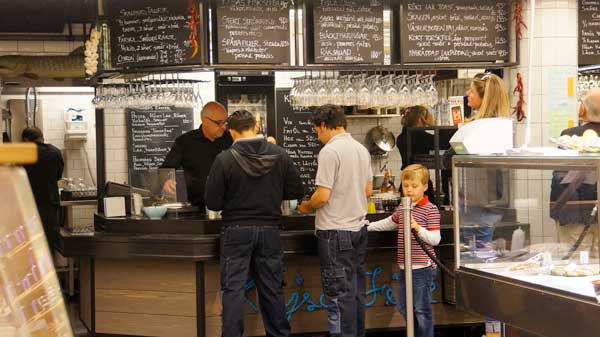Watch-theft in Stockholm is drastically increasing. Most seem to be targeted and well-planned. Social media may be a research tool for the thieves.
Continue readingGypsy Beggars in Sweden: Documentary
If you’re even a little interested in the explosion of gypsy beggars across Europe, and particularly in Sweden, you must see this documentary. It’s Bulgarian with English subtitles, in three parts.
Gypsy Beggars in Sweden
“Bulgarian TV host Mirolyuba Benatova interviews bulgarian gypsy beggars in Sweden and asks questions about their income and the criminal aspects of it.”
If you watch the documentary, please tell me in the comments below: Did it change your mind in any way? Did it confirm something you suspected? How was it enlightening?
My previous articles on the subject:
Stockholm beggars incite political daring

Stockholm beggars, still clogging streets, store entrances, and subway entrances throughout the city, reflect a problem all of Sweden is experiencing. The beggars come primarily from Romania and employ such identical passive approaches that it’s hard to believe they aren’t shown, by some phantom figure (boss), exactly what they are to do.
Stockholm beggars
I wrote extensively about beggars in Stockholm a year ago, describing links between these beggars and organized crime syndicates in Romania. I then traveled to Romania to further research organized crime and human trafficking of beggars (and pickpockets). The comments posted to these articles, and others, reveal the divisive split among Swedes who, as a friend of mine quips, are either beggar-huggers or xenophobes.
Thus, the stage is set for a polarizing political agenda, which the Sweden Democrat Party has just taken to a new venue: the Stockholm subway system. There, bold text in English begins:
“Sorry about the mess here in Sweden. We have a serious problem with forced begging. International gangs profit from people’s desperation. Goverment [sic] won’t do what’s needed. But we will!”
The party has taken this anti-begging platform to the subway platform where, ironically, one is likely to have just witnessed the very subject of the platform immediately before coming face to typeface with its blatant message. One must step around at least one sprawling beggar at virtually every subway door.
Why is this audacious political message in English? Why is it in the subway at all? Well, the public transport system can’t discriminate among advertisers, so it can’t stop the ad campaign. And though the ad pretends to inform foreign visitors, it is obviously speaking to Swedish voters (who practically all speak English).
If you visited Sweden four or more years ago, you doubtless remember the pristine condition of public and private spaces. One can’t help but notice the stark difference today. Beggars languish here and there on pavements made filthy with dark stains. Stuffed black trash bags are piled near each beggar, sometimes in baby strollers or shopping carts. Laundry is spread on the ground around some beggars, along with beverage cups, food packets, and blankets. The areas they squat look like mini-slums.
The message in the subway specifically targets forced begging, which is the heart of the controversy in Sweden. Are these beggars organized and trafficked by crime bosses? Or are they desperately poor, unable to get help in their home countries, and seeking a better life in a rich nation full of possibilities? Or are they seeking a lifetime of handouts with no intention to immerse themselves in a new culture, learn the language, seek gainful employment?
The beggar-huggers must believe that all these East European beggars—all several thousand of them—came as sole and separate individuals; and that each is uneducated, each unable to work—yet each has organized herself (most of these beggars are women), traveled herself, found her own begging place and sleeping place, her own laminated family photo to display… It’s impossible to imagine these passive women, who at most now whimper “hej-hej” (hello) to passersby, mustering the gumption to attempt such an international endeavor.
The xenophobes blame immigrants for the mess. Others cry racial foul. But the hatred isn’t for an ethnic group—it’s for a work ethic. Begging has been a rare phenomenon in Sweden, therefore arousing real sympathy. Altruistic Swedes readily opened their purses. Now, with a beggar on every corner and ubiquitous rumblings of organization by crime syndicates, Swedes are uncertain, confused, afraid to trust their innate generosity, and afraid of what others will think of them if they don’t.
Car scam. Sellers beware!

Closing up our Stockholm house, I’ve been selling things on the local version of Craig’sList. Many items sell in the first day, even in the first hour after an ad goes live. Most buyers don’t try to bargain; they simply pay the asking price. Sure, that’s partly the Swedish character. Pricing items low has a lot to do with it, too.
After success with many items, I decide to list our car, a 15-year-old Saab in almost-new condition with only 83,000 miles and not a thing wrong with it.
The phone rings a few minutes after the ad is posted. The caller wants the car! He makes a half-hearted attempt to lower the price and Bob, who has taken the call, agrees to the little discount. The caller says he’s in Uppsala, a nearby university town, and it will take him a little more than an hour to drive down with a friend. Okay. The caller asks for explicit driving directions, and Bob gives it. The caller tells us to take the ad offline, since he’s coming to get the car. Bob says sure and finally hangs up.
Car Scam!
Bob relates all this to me and I become a little testy. What do you mean you agreed to a discount? Of course I’m not going to take the ad down! Not until I’ve actually sold the car. And who calls to say they’ll buy the car sight-unseen, instead of saying they’ll come take a look at it?
Several minutes later, I get an email from “Joel,” who writes that it sounds like a good deal, when can he come see the car? I tell Joel that we have buyers on the way, but come tomorrow morning unless I write that it’s been sold.

Uppsala guy calls again. He’s driving, and in a chatty mood. He asks Bob endless personal questions. Overhearing Bob’s replies, alarm bells begin to toll in my head. The guy asks for driving directions again. Bob gives him turn-by-turn instructions. It sounds as if they’re close, since Bob is naming nearby streets and landmarks. They couldn’t be here already, all the way from Uppsala.
Anyway, what kind of people don’t have GPS nowadays, I’m wondering. Why are they asking for the same simple directions over and over? It occurs to me that they’re simply tying up the phone line, trying to prevent competing buyers from getting through.
The Uppsala guy and his friend arrive. They couldn’t have driven all the way from Uppsala so quickly. Bob goes outside to show them the car. I observe from the upstairs window like a suspicious witch.
The man is about 26, I’m guessing, and my first thought: he’s the son or husband of one of the hundreds of beggars parked on the pavements of Stockholm. Nope, I have no evidence of that; it just pops into my head.

It’s dark and below freezing outside. An icy wind numbs my face at the open window. They’re speaking Swedish below. Long conversations. Wild gesticulating. Brief looks inside the car and under the hood. The guy from Uppsala starts the engine and complains about the look of the exhaust, but he never asks to drive the car. Meanwhile, the friend’s SUV is idling.
Bob tramps upstairs. “The car has a ton of problems! It’s a year older than you claim in your ad. The odometer has been rolled back. It’s had ten owners before us. And there’s water in the oil. He made a low offer, but I think we should take it.”
I explode. “Why do you believe him? He’s a scammer!”
“He showed me the car’s history on a website.”
“Right—on his smartphone! His phone with internet and GPS and maps. Why do you think he kept you on the phone for 20 minutes asking excruciating details about how to get here? He just wanted to keep the phone busy so you couldn’t take any other calls!”
“Let’s take it. Saab’s bankrupt, the car might not sell at all.”
“It’s the first day! The first hour! And I already have another interested person. A guy who wants to see the car before he buys it.”
“I’ll try to get the price up a little then…”
“No. In fact, forget that discount you agreed to on the phone. For this guy, the price has just gone up. Full price in cash, or nothing.” I am a witch.

Bob goes back downstairs disappointed. The witch put in the ad, photographed the car, and therefore gets final word on the sale. The SUV has been idling all this time. Ready for a quick get-away? Foul fumes float into my face at the window. The scammer persists and keeps Bob in negotiation for another 15 minutes before he finally speeds off.
I email Joel and tell him the sale didn’t go through. He comes over immediately to look at the car, test drives it, asks to see its “besiktiningar,” an official document showing any work done prior to the car’s last registration. Joel tells me the car is a great deal at the asking price, and buys it. He pays cash.
Sold, in under two hours.
And the next day Joel returns to help us with an errand for which we need a car. We did not expect the car to sell so quickly. Nice guy, Joel.
I wonder how Uppsala guy would have paid, had we made a deal. Just guessing: he’d flash cash, but not enough—oh, sorry, that’s all I could get from the cash machine—then offer to pay more than the agreed price via PayPal—a phony account. Or… no. Why then, bother to negotiate at all? Because by then, we’d be convinced we’d never sell the car, it’s such a mess. Or is he a “short-changer” who knows how to fold cash to make it look like more than it is? This part, we’ll never know.
Most interesting: what happened to Bob’s scam-sensor? Why did he fall for this con artist’s story? Okay, the scammer must have been smooth. (They all are.) He was prepared with fake “evidence.” And we’d dealt with so many honest buyers before this one. And Swedes are pretty decent, on the whole. Bob’s guard was down. Yeah. Excuses, excuses. Reminder: we can all be taken. Stay alert!
Arlanda shopping trick—offensive

Like shopping? Like to be forced into shopping? Ever feel like boycotting a store because of the arrogant manner shown towards its customers?
Arlanda shopping trick—offensive!
Like to take the loooooong way around? Stockholm’s Arlanda Airport uses luggage carts to blockade the quick way—the desirable way—to the gates. After security we used to be able to take a quick left and get promptly to the lounge, or to the gates. Now (actually it’s been this way for some years), the way is blocked and we’re forced to make the long trek through the store. Only to then turn left and backtrack outside the shop all the way back to where we started.
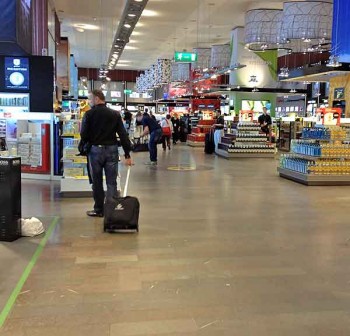
It’s presumtuous and insulting. They don’t know if my feet hurt. They don’t know if I’m late. They don’t know if I’m desperate for ten extra minutes of internet before my flight. Or a quick meal. Or a bathroom.
I’d like to organize 50 people to clear security with me. We’d each take a luggage cart and park it elsewhere, clearing the way to avoid the massive so-called “duty-free” store and allowing us to use the most efficient exit.
We travelers should have the choice.
Claes is kind. Claes is gone.
Bob Arno writes about his brother. Bambi interrupts.

Over the years I have written about my mentors, my old friends who have had a significant impact on my career, as well as a few obituaries — friends who were taken from us way too early. Writing about mentors is not hard, just go back in time and analyze why they were unique and how they extended themselves and helped a young inexperienced entertainer.
But today I have a far more personal challenge, in the midst of my sorrow for the loss of my own brother. He passed away about ten days ago, at age seventy. That’s far too early for a Swedish man who lived healthy, never excessive, and always in great trim shape.
Bambi: It was only two summers ago that he lifted tall Frida from the ground when she hurt her ankle on a trampoline in Arizona, and carried her like a baby a long distance to a sofa. He carried her as if she weighed nothing. In retrospect, we know that Claes was already ill, though none of us knew it. But he was still strong as an ox!
How does one explain the random selection of cancer victims? In my work I am obsessed with pattern recognition and the logic of why some people become victims (to criminals)—it’s all very neat and clear when looking at the bigger picture. But cancer can strike anyone, young or old, with little warning, as was the case with my brother. A little over a year ago he noticed he couldn’t quite swallow food as easily as before. He suspected some sort a throat infection. In September 2013 the tests came in: advanced esophageal cancer, located at the bottom of the esophagus, as well as smaller tumors in the stomach. No option to operate, only chemo therapy remained.
The doctors gave him a year, at best, and that is exactly what he got. In this year he never gave up, never resigned, but knew deep down that it was probably hopeless. He prepared as most cancer patients do for the inevitable. The legal documents, the transfer of properties, the farewell parties with his closest friends. Nobody around him suspected the rapid deterioration. Yes, his weight became an obvious red flag, but he did not look gaunt, and his face had the same round, filled-out cheeks as before. When he was in a good mood, nobody could possibly suspect that we all counted days and weeks.
My brother, Claes, lived in Sweden, where end-of-life health care is exemplary and caring. Every evening a nurse came by and hooked Claes to a drip tube, connected to a port in his upper chest close to his neck. During the night he would then receive about a liter of a milky nutritious fluid, while sleeping. Every morning the nurse returned and disconnected the tube. No, it was not good “quality of life,” since he could barely eat anything at all for close to a year. Always nauseous, and during the last six months of his life steadily more in pain, as the tumors grew and pressed against spine and sensitive nerve centers. Strong doses of morphine only sometimes helped.

So why did he maintain the illusion that maybe there was still hope for a new miracle drug? Stronger men at age 69-71 might have said “I had a good life, enough is enough, let’s not pretend anymore.” But Claes enjoyed every minute he had on the telephone with his friends, with me and my wife, and simply living another day. For 365 days when I couldn’t be with Claes, I called him daily for about an hour. We stayed with him whenever we could and behaved like we always did. Sat around the dining table and joked around, talked over current events, old anecdotes, and memories. There were lots of those and lots of laughter.
Bambi: Like that utterly believable postcard Claes sent us from Naples, pretending to be a gang of thieves thanking us for visiting Naples, and complimenting the film National Geographic made about us and them. It was brilliant, the way he mixed a little Italian in with poor English. Did Claes, with his love of all things Italian, and his reverence for the ultimate practical joke, travel to Naples just to send that postcard? It would be just like him…
But I never brought up the obvious: what do we do for Claes’s funeral, who should attend, how should we deal with this or with that? We both pushed aside the inevitable, the closure of it all. But he was not living in a dream world. He knew full well that some things just had to be done, despite the great expense in terms of his energy.
Sweden does not seem to have an end-of-life option for the patient, as is the case in the Netherlands and Switzerland. But there does not seem to be a heated dialog, either, like in the United Kingdom, about patients’ right to request a doctor’s help to terminate life. Having watched my brother suffer for a year I must ask myself why there are no choices. I’m not going to list all the horrible and painful moments my brother experienced in front of my very eyes. In retrospect, when everything is said and done, I think he still would have preferred to live just the number of days he squeezed out of his treatment and the help from the Swedish medical support system. But I would have chosen a different tack, which only means that people have different preferences and there should be an option for ALL. Not forced medical support (for whatever reason).

My relationship with my brother was unique. During the early years of my career he helped extensively with the management of promotional material back in Sweden when I was traveling around the world. But my work in the sixties was mainly outside of Sweden with few visits to my home country and so we were not as regular or intimate as in later years. Long distance phone calls in those days were costly affairs, only to be used for urgent matters. It was not until the early eighties, thirty five years ago, that I re-cemented my close friendship with my brother and we started to visit each other’s homes. Eventually this grew to extended stays on two continents, permanent possession of each other’s house keys, and “my house is your house.” We regularly visited one another for months on end.

Bambi: When in the U.S., Claes often referred to himself as an “Okie” or a country bumpkin when he felt unfamiliar with an American tradition. Like the time he drove alone to a plant nursery and his car was rushed by a gang of shouting Mexicans. Cold sweat, pounding heart, knuckles white on the steering wheel, Claes inched forward, terrified. Oh, did we ever laugh about that experience! Just a word of the story could forever after bring any of us to gales of laughter.
The friendship was equally warm between Claes and my wife. They were like brother and sister. We were a unique trio with shared interests and missed each other very much when apart. I would assume that only married couples or siblings can have the kind of close and warm relationship that years of sharing fosters. It was the humor, the jokes, the ribbing, the advice, the practical jokes, the insults, and the support, that was unique and is now missed.
Bambi: How could I not tease him about the creative way he shelved his books?
There wasn’t a dinner or a telephone chat (thank you Skype) when we weren’t laughing uproariously.
Bambi: Remember when Claes bit into a Chinese fortune cookie, made a face, and complained that there was paper in his cookie?

Gags or lines often in bad taste or politically incorrect, but biting and pure. No facade or pretense, just gutsy and honest observations with ever-present sardonic over-tones. Guards-down: the sort of rapport you can otherwise only have with a mate from school or the military, and hopefully with your marriage partner. (Or as they call them in Sweden “sambo.” Only forty percent of Swedish people marry—the rest live together under the label “sambo.” Never any spousal support after a break up, but child support works the same way, married or “sambo.”)
Claes had two lengthy “sambo” relations, each lasting about ten years. But he lived alone for the last fifteen years. He felt he lived full life, but regretted that he had not found a partner to share his later years with. He had a preference for exotic appearance and had relations in Latin America and the Middle East which never materialized into something that could become reality back in Sweden.
Bambi: Maybe he lived alone because of his famous stubbornness, huh? Would anyone else behave the way Claes did when airport security told him he couldn’t fly with his pocketknife? He wouldn’t give it up to the security officer, whom he knew would keep the gorgeous little knife. Instead, he was determined to destroy it. Except… it was a strong little knife, a fine German one, and he almost missed his flight because it took him so long!
His love was travel, photography, and the study of ancient civilizations (art, monuments, and history). He spent fifty years taking magnificent photos in every corner of the globe. He was a lecturer in Sweden with a strong following and his appearances always drew an adoring crowd of fans. It was not a big financial reward since culture lectures are not exactly big money-makers, but he was re-booked over and over for the same venues, year after year.

Bambi: Let’s not forget his love of tree-killing! Has any man felled more trees than Claes has? I was awed when I watched him single-handedly take down a huge mesquite in a tricky position at our Vegas house. But it was nothing compared to seeing him waving in the wind at the top of a giant fir on his country house property—a man with a fear of heights, yet! Over the years, I’ve watched his mountain of tree roots grow.
Oh, we did so much together. We gardened, we went on petroglyph-seeking road trips, we cooked. He taught me to make a killer Jansson’s frestelse. We made flädersaft together with the most old-fashioned tools.

All his friends will remember Claes for two things. His kindness and his desire to help. For many years he worked in human resources and it is amazing how many old friends have now come forward and expressed sorrow over Claes’s passing, always commenting on how much he helped them both professionally and with private trauma and complexities. He was a sensitive soul who wished well for others and always extended himself to others and their need for support.
When we were quite young, maybe about 12 years old, he wrote on a door to a tool shed that I had, “Claes is kind.”
I guess you could characterize Claes with those words—Claes is kind. I believe his friends will all remember Claes first and foremost as a kind and funny guy who passed away much too early.
Do you agree?
Romanian beggars

I recently wrote about beggars on the streets of Stockholm. I observed that an abundance of beggars are now stationed in the streets, and that they are mostly from Romania. I argued that these beggars are organized, and possibly trafficked, that a large portion of collected money goes to “bosses,” and that Swedes are naive and therefore an easy market for the begging enterprise, which is in large part social engineering. The article became quite controversial, especially in Sweden.

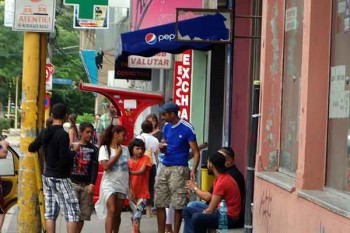

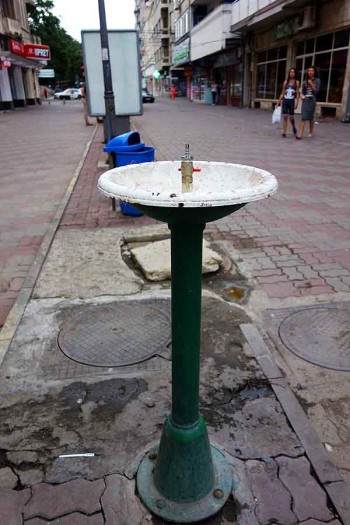





Now, after making a trip to Romania, I have some follow-up information. (But you have to read through my rant before you get it.)
Romanian beggars in Sweden
Swedes are reluctant to believe that their cities and towns have been besieged by professional beggars. Despite the thousands of Romanian beggars in evidence, Swedes stubbornly insist that these are simply individual unfortunate humans who can survive by no other means. For some reason, Swedes excuse them from working for a living. Despite the fact that the Romanian beggars (individually!) all use the exact same posture, the same dress mode, the same plastic bundles of personal effects, the same blanket-wrap and paper cup and laminated photo—even the exact same laminated photo of the very same children. Despite the fact that prime “locations” seem to be continuously occupied, with methodical rotations of personnel so that the position is never vacant, never vulnerable to being usurped by a competitor. Despite the fact that these locations follow a scheme favoring the doors of particular grocery and liquor stores and subway entrances, all over Stockholm and all over Sweden.
Really. Are these Romanian beggars—all the several thousands of them—each sole and separate individuals, each uneducated, each unable to work, each self-organized?
Is Sweden a country of ostriches with their heads buried in the sand? Not quite. Sweden holds a native population intensely dependent on social proof. Everyone is terrified of committing inappropriate behavior, voicing an unpopular belief, not conforming to the group mentality. Everyone’s afraid of appearing to lack compassion, sympathy, charity, and brotherly love. Everyone’s afraid of appearing racist.
For an excellent example of this attitude, take a look at an August 28, 2014 article in Metro, the free paper distributed on Swedish trains. “No, the beggars are not controlled by criminal gangs,” is a translation of the Swedish headline. Its main source of intelligence is a Swedish “homelessness coordinator.” I don’t know, but I would suspect that Romanians who occupy Sweden for the purpose of begging do not go to the state for housing. That’s why they have bosses! To organize them, find them places to sleep. Also note that they carry their possessions around with them in sacks, like old-fashioned hobos.
Other sources in the article tiptoe through their interviews, cautiously hedging with evasive statements like this police officer’s: “‘It is very difficult to say that begging is organized,’ says Stockholm Police Peter Enell.” The article also makes short shrift of the statements by “a police officer with roots in Romania.” To me, the Metro article is laughable. Have a look. Or don’t waste your time.
To find out more about Romanian beggars, Bob Arno and I went investigating in Romania.
We met with a highly experienced police officer and another official in the city of Constanta, neither of whom would like to be named. Both told us that Romanians who beg outside of Romania are definitely organized. (I did not ask about beggars inside Romania.)
I asked if poor villagers sought out begging gang-leaders for assistance, or if villagers were recruited by the gangsters. They are recruited, I was assured. They are desperately poor, and they are Roma. On their own, they could not afford foreign travel. They require the assistance of leaders (bosses, aka gangsters) who organize their transportation. Of course, these bosses must be repaid.
The police officer told us that local gangsters who head begging rings gamble away much of the bounty. Other investigations show that begging and pickpocketing proceeds transform destitute village shacks into relative mansions with European luxury cars parked in driveways.
The official pointed out a number of Roma men drinking on the sidewalks. They are robbers, he said.
The police officer said that people are still maimed for the purpose of begging. I did not get clarification, but I take this to mean that it is children who are maimed. The officer described a horrendous practice, in which adults push a child into slow-moving traffic. When the child is hit and injured, the adults demand cash on the spot from the driver in order to not involve the police.
It’s hard to believe that this barbaric savagery really happens. Yet, the officer told us that this exact atrocity had occurred only two days before our meeting, right in the center of town, in front of Tomis Mall (near where we found our pickpockets the next day). I can’t get the nightmarish image out of my head.
I must presume that the adults were not the parents of the child victim. Who is the child, then? Stolen? Purchased? Rented? I also presume that the child, with its unpredictable injuries, is intended to become a compelling beggar who will attract sympathy and more cash with its twisted limbs and scarred skin.
This anachronism is difficult to grasp in modern, civilized society. It’s impossible to imagine the desperation and cold-bloodedness that leads to such an industry.
(It brings to mind the 1989 novel Geek Love, by Katherine Dunn, in which a circus family man concocts chemical cocktails for his pregnant wife, thereby creating his own deformed children for his own lucrative freak show. However, those children are loved. Great book!)
Roma in Romania
Bob and I spoke with a gypsy family that happened to walk past us in Constanta, Romania. Our translator begged us not to, insisting that it would bring trouble and they’d demand money. He said they wouldn’t speak much Romanian and he didn’t speak any Romany. Bob persisted, and the family sat down in a nearby park, amenable and unperturbed.
They were clearly penniless. The mother’s clothes were black with muck and she carried a grubby blanket. The children, eight and eleven years old, were bright and alert. They answered Bob’s questions with the same trepidation any shy children would, glancing at their mother, who smiled back and nodded. The children attended school. The mother had not.
I was enchanted by the little girl, whose scarred and dirty face was beaming one moment, serious the next. Her radiant smile baring two chipped front teeth hinted of a tough life. Her rubber sandals were cracked, broken, and dirty. Her feet were caked with grime, her toenails chipped and encrusted. She wants to be a doctor.
The mother has five children: 3, 8, 11, 15, and 20. They live in a house where they pay a small rent. The children’s father is very ill, she told us. He was hit in the head recently. But she doesn’t drink or smoke, she emphasized, as if to counter an unsaid accusation. Also, her brother has been arrested and is in jail for two years. She didn’t elaborate, but added that she’s not afraid of police. She’s sad that she doesn’t have her own house—that’s her dream. To support her family, she collects plastic bottles.
“You ask hard questions,” our translator said, “very personal.”
Now Bob beat around a bush. Without asking directly, he tried to find out if the family had been approached by human traffickers or gangsters offering them a better life. He spoke directly to the children.
Our translator was not familiar with our peculiar area of interest and had no idea what we were getting at—which is just the way we wanted it. No interfering, no answering on behalf of the family or spinning their replies. It was interesting to observe his change in attitude. He softened toward the children, he was charmed by them, and impressed by the mother’s candid and sincere statements.
When Bob invited the mother to ask him questions, she had none. She simply smiled and said “I’m glad that you asked us all these questions and pleased that you are interested in our life.”
The family did not ask us for money, though we gave them some at the end. The children handled the bills reverently, then handed them to their mother. The woman was surprised and grateful.
Criminal Romanian begging rings
I have not seen any children (Roma or otherwise) begging in Sweden. I’m sure it wouldn’t be tolerated. However, Romanian children beggars and pickpockets are plentiful in England, Italy, Spain, France, and probably additional European countries, but those I have listed I have personal experience with.
Here’s a 2-minute BBC clip on Romanian child-beggars, human trafficking, begging-ring bosses, and new riches in poor Romanian villages.
http://www.youtube.com/watch?v=9n3K2OEmTe0
Beggars in Stockholm
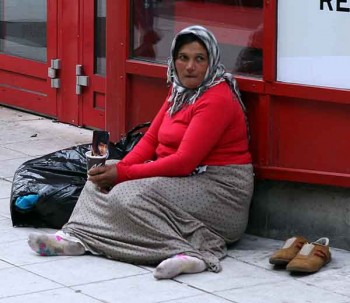
Beggars in Stockholm—everywhere!
Just a few years ago, one never saw beggars in Stockholm. Today, one never sees Swedish beggars, but beggars from Romania seem to be on every corner, at the door of every shop, and at every subway station entrance. It’s an orchestrated invasion; just like the organized Gypsy begging that has been investigated and documented in the U.K. However, in Stockholm, I haven’t (yet?) seen child beggars. Not even babes in arms. I suspect the kingpins are smart enough to realize that Sweden wouldn’t stand for that.
The Swedish government periodically debates the possibility of banning begging, but then, what would happen to the few homeless and drug-addicted Swedes who beg, and the few alcoholics out on the street? Where would they get cash?
Well then, let’s ban begging by foreigners! Good idea, but unlikely to happen any time soon, I think. Everything in Sweden happens by committee, and happens slooooowly.
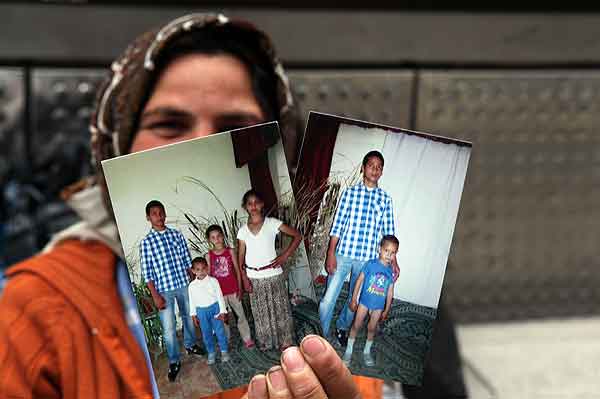

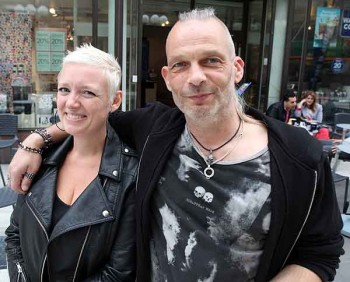

When border control within the European Union went soft, it didn’t take syndicate leaders long to take advantage of the new freedom of movement. Transnational criminal activities increased, particularly human trafficking.
For now, EU citizens are allowed to come to Sweden and stay without permission for up to three months. The Gypsy bosses know the rules. They transport the poor Romanian villagers, house them, feed them, and ferry them to their assigned begging spots. They come along and empty the cash-cups periodically.
Like the employees of a global theme park, all the Romanian beggars in Stockholm seem to be clones, all carbon copies of a model with a signature style. They all sit, they’re all wrapped in a blanket, they all hold a paper cup, and they all show photos of children. They all have a number of plastic bags near them, stuffed with things. They all block the flow of traffic.
Sweden is perfect…
Sweden is an excellent venue for this racket. Its citizens are wealthy, compassionate, and to some extent naive. The government is hamstrung and afraid to act. Tourists are rarely the budget type. I see people contributing to the cups (to the bosses’ riches); I’ve never seen meanness or complaint toward the beggars, not even hey-you’re-blocking-the-way.
The issue, the poor-Romanian-beggar, abused-victim-or-system-abuser conundrum, fraught with racial implications, is a bush to be beat around. In Sweden, there’s a ubiquitous fear of “what others think.” Everyone’s afraid to appear incorrect.
We spoke to a couple just after we saw them hand over a hundred crowns (about US$15) with a kind word and pat on the beggar’s arm. They give often, they said, whenever they can. They know these people are poor and need the money to feed their children. The couple buys into the scam hook, line, and sinker. Oh, I believe the beggars are poor and, since they don’t work, need help to support their families. But even the Romanian ambassador to Sweden thinks begging should be outlawed (and acknowledges that the beggars are her countrymen).
The beggars’ bosses* keep track of time. When three months are up, the gang is packed up and moved on for another stint elsewhere. Meanwhile, those at the top of the organized hierarachy build palatial houses back in their dumpy Romanian villages, and poor Romanian parents who “rented out” their children to begging and pickpocketing rings likewise see relative wealth.


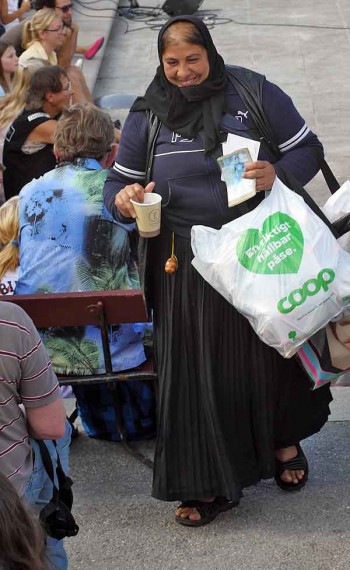


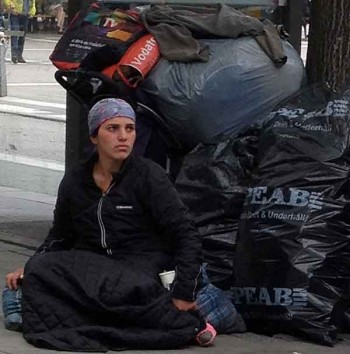
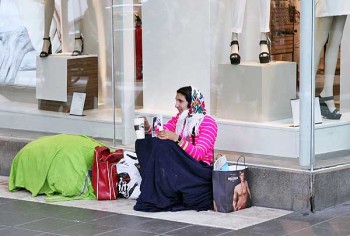

Bob and I strolled through Kungsträdgården, a central park area in Stockholm, while a street performers’ festival was in full swing. Magician Charlie Caper, surrounded by a good crowd, was mid-routine when one of these Gypsy beggars actually waddled on stage and joined him.
Atypical for her type and oddly gregarious, she seemed to thrive on the magician’s reflected attention. The brazen beggar gestured, she pointed, she ta-da’ed. And when the crowd applauded for the magician, she soaked it up all-smiles and headed into the audience with her cup and photo, as if she were collecting for her talented son. The audacity!
Is it good to give?
Let’s say for a moment that the gypsy beggars in Stockholm get to keep all the cash they collect. I know—but just for arguments’ sake. Then subtract what they must pay for transport from Romania and in three months, to some unknown point (by crowded bus?). And subtract what they pay for food, lodging, and local transportation (which is not cheap in Sweden). They must be gathering a pretty penny, to make their long days on the cold pavement (Sweden, winter…) worthwhile. Citizens and tourists fill the beggars’ cups and the Gypsies (often seen talking on their mobile phones) call their friends and relatives back home and urge them to hop on the next bus to Stockholm, the deal’s great.
Or let’s say it’s not like that at all. The beggars are basically slave labor, trafficked humans, forced to sit on the pavement all day, forced to follow company protocol behaving just so. Strict overseers collect the beggars’ takings periodically and they are given a small wage. Most of the money donated by good samaritans goes into the pockets of the ringleader who—it’s well-established by now—builds palatial mansions (relatively speaking) in Romanian villages otherwise full of wood shacks.* The whole enterprise is a social engineering stunt—one huge scam exploiting public empathy and generous social services.
Either way, depositing funds into the cup-accounts of bundled beggars on the street is not a smart way to help. It rewards the begging enterprise, feeds the criminal organization, and ensures the continuation of the practice. Donors are kindhearted patsies.
Of course Stockholm isn’t the only city under siege. In fact, all of Sweden, even small towns in the frigid north, has been invaded by organized Romanian beggars. Denmark made headlines when Trine Bramsen, justice police spokeswoman for its governing Social Democrat party, said “We don’t want to make Denmark a hotel with a reputation across Europe for free food and board.” She wants them to “choose another country, for example Sweden, where they know they have better possibilities.” Looks like that’s working.
Some parts of the Austria, for example Tyrol and Salzburg, tried to ban begging altogether. But the Constitutional Court overturned outright bans, ruling that begging is a human right.
Dublin has been cracking down on organized begging for years now. In Spain, almost 100 people have been arrested for running human trafficking rings in last three years. “Most of the detainees are Romanian nationals, as are their victims, who are brought to Spain by the rings. In nearly all of the cases the victims were promised well-paid jobs in Spain, but once here they were made to beg on the streets in exchange for a sandwich and a bed inside a shelter.”
The European Union is desperate for a solution but the problem is huge—far bigger than organized begging, even though these rings fall within the realm of human trafficking. “The problem of human trafficking in the European Union” is good read, freshly presented by the European Parliamentary Research Service.
A tool to combat trafficking, is knowledge of its causes and vulnerabilities of victims. This Romanian study of trafficking in persons for forced begging provides such a picture. It highlights the vulnerabilities of potential victims, the characteristics of traffickers and outlines recommendations on combating both these aspects. This study will assist in facilitating ongoing campaigns and cooperation to fight against this heinous crime, to fight for the protection, assistance to, and dignity of the victims and most importantly, to prevent trafficking.
Trafficking in Persons for Begging — Romania Study
Well-meant donations to beggars enrich the criminal syndicate leaders and further enslave the individuals forced into begging. Giving to beggars is misplaced kindness. The gift does not remain in the hand that receives it.
*Edited 7/29/14 to add support and sources:
“The leaders of a child-trafficking operation that put hundreds of beggars on the streets of Britain were targeted in a series of raids today in a remote Romanian town where opulent mansions have sprung up since the country joined the European Union. … at least 17 people were arrested after the raids on 33 homes in Tandarei [Romania] by a small army of organised crime investigators, assisted by 26 Metropolitan Police officers and two observers from Interpol. … Firearms, jewellery, luxury cars and large sums of money were found at the homes of suspects, according to local media, which said that 320 Romanian officers were involved in the operation. Tandarei, with its population of 12,000 people, 150km east of Bucharest, has undergone a seemingly miraculous economic boom in the past few years.” Police in Romania arrest leaders of child-trafficking operation in UK, The Times, April 8, 2010
If you don’t have a subscription to The Times and do not want to pay £1, the text is also here. Underline above is mine.
Also see the BBC documentary “Britain’s Child Beggars.”
Edit: See follow-up article after our fact-finding trip to Romania.
Edit: Finally, 10/4/14, Sweden admits out loud that the beggars are organized and pay big bucks to bosses. Beggars are Forced to Pay, in Dagens Nyheter, Swedens biggest daily paper. Here’s a Google-translation of the page.
Edit: It is mid-December, mostly dark and freezing out, and I see just as many beggars as in the summer. Perhaps more are in the subways and inside the entries of grocery stores than out in the streets, but they’re in full force. Well-bundled, at least.
Edit: See Stockholm beggars incite political daring about the controversial anti-begging ad prominently placed in a Stockholm subway station.
Edit: Over six days walking all over London in August 2015, I saw exactly two beggars. Police tell me they are removed from the streets immediately and given food and shelter.
Edit: Sweden’s making progress! Now the official word is: “Stop giving money to beggars.” Here’s a Google translation of the article.
“Ghost pickpockets” – or white-dressed beggars?
Are they just white-dressed beggars?


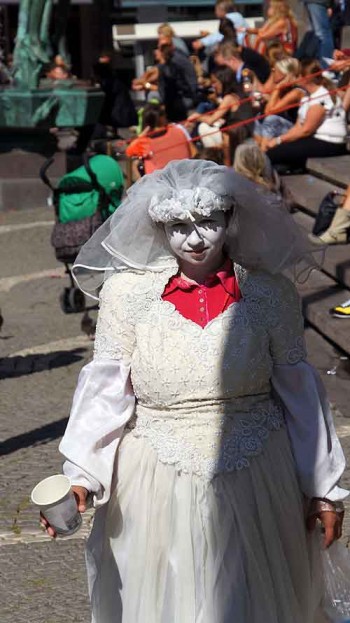

White-painted, white-draped “ghosts” are picking pockets in Stockholm’s most beautiful district, the national paper blared. Police are quoted: “The thieves are constantly finding new methods. Most often, prior to the theft, there is a distraction of some sort. These people are very aggressive and pushy which causes people to become quite perplexed.”
What? This sounded fishy to us. We’d noticed these people in Gamla Stan, Stockholm’s old town, all summer. Some approach with a begging hand or cup. Others appear abruptly and, oddly, lean in closely making kissy sounds, then bound off. Others offer to pose for photos.
How could these be pickpockets? Why would a pickpocket dress in such an obvious costume? Why would she face her victims so imploringly? How would the thief disappear once he’d stolen?
Sometimes they’re just a distraction, the police explained, according to Dagens Nyheter. They have partners who do the stealing.
So thiefhunters went looking for ourselves. Yep, they’re still there.
Costumed: dramatically.
Aggressive: yes.
Stealing: no.
Sometimes we saw partners, sometimes we didn’t. No matter—this M.O. did not make sense.
We tried to speak to a white-faced man in a sheet. He claimed to speak Italian but none of Bob’s rudimentary Italian worked. We’re pretty sure he’s from a country east of Italy. The man was cagey, but polite. He smiled blankly. He didn’t try to break away, but occasionally shook his cup at Bob, as if to remind us of his mission. If he understood anything we said, he didn’t let on.
Later, when approached by a begging white-clad female, I raised my camera and took her picture. She tilted her head and tipped her cup. I shot another few pictures and backed away a step. She advanced with a bland smile, apparently willing to continue this dance as long as it took.
But, of course they smiled and waited patiently. As we observed the ghosts in the act of begging, we saw almost half the people they approached drop coins into their cups! I’ve never done a survey of begging methods, but this seems like a high rate of return. These ghosts have a successful operation. They’ve found an M.O. that works. They’re smug.
But are they pickpocketing?
We called on our friends in the Stockholm Police Department. “The white-robed and white-painted people in Stockholm are beggars. There is no evidence whatsoever that they are pickpockets,” Officer Rolf Edin said emphatically. Their pushiness may cause people to believe that they are pickpockets, he posited.
Also, the policeman said, some of these white-robed beggars do some sort of performance, which gathers a crowd. “And pickpockets are drawn to a crowd like flies to a sugar cube,” he said, but that doesn’t mean that the white-robed beggars are in collaboration with the thieves.
Then what of the big bold newspaper headline, Police warn of white-clad “‘ghost gang’?
“So far, it has not been possible to stop the ghost gang, which is believed to be behind several pickpocketing thefts,” the paper quoted police. Well, the named officer claims to have been misquoted, we were told.
Right. The paper ran the sensational headline. The writer chose to interpret every general statement about pickpocketing in Stockholm as an indictment against the mysterious white-dressed beggars. She didn’t answer my questions to her, except to acknowledge that she did speak with the officer she quoted. Somehow though, she got the story terribly wrong.
Thiefhunters are myth-busters
We surreptitiously tailed many of the white-dressed beggars as they looped the streets. In addition to the Stockholm police, we spoke with many people who work on the streets that the white-dressed beggars haunt. Shop owners, managers, living statues who see everything all day… They all said yes, they see the white-dressed beggars many times each day. No they haven’t seen them steal, haven’t seen any problem, haven’t had any complaints. Most of them had not even seen the accusation in the newspaper, though one had seen the suspicion raised in a tv news report.
Thiefhunters’ take: Nope. The white-dressed beggars are not pickpockets. They’re beggars. Why are they dressed in white? Good question. But why call them “ghosts”? One is wearing a wedding dress and veil. Another is in rainbow clown hair, for goodness sake. Answer: “Ghost Pickpockets” is a great headline! It sells papers.
The white-dressed beggars who jump into your face are certainly irritating; but pickpockets they are not.
Kajsas fish soup, Stockholm
Kajsas fish soup

I dream of Kajsas’ fish soup! Since I started visiting Kajsas Fiskbistron (fish bistro) in the 90s, I always order only that. It’s a hearty red broth stocked with fish like a dude ranch pond. Miraculously, the large tender filets are boneless.

When you order, you say yes or no to additional spoonfuls of cooked shrimp (yes!), shelled mussels (yes!), and aioli (absolutely!). Then you add your own double-dollop of harissa (spicy Moroccan chili paste) (essential!). Feast in a bowl!
The free “salad,” on my last visit a few days ago, was shredded napa cabbage, a nice, crunchy complement. I seem to remember other simple salads on other visits, but you don’t go for the salad. Bread is included, and so is water.
You can order other seafood dishes, but why? Plenty of tasty choices are on the blackboard menu, but only a few people seem to order them. They must be frequent visitors who work nearby. Just get the fish soup and swoon. There’s a bar, too, so you can have a beer with it if you like.
Located inside a top-quality food hall, Kajsas must source its fish from the neighboring seafood dealers—I’m presuming here—or maybe the restaurant buys from the same fishmongers the neighbors do. Regardless, you imagine you’re eating the fishermen’s own stew.
I love the atmosphere, even though the place is indoors, underground, in a market, with a giant, shiny Patagonian toothfish staring at me from between the octopus and baby squids in the glass counter across the aisle. It’s not romantic or scenic or high-design—just authentic, unpretentious, and efficient.
Kajsas Fiskbistron is in Hötorgshallen, in Hötorget, Stockholm. Take the escalator down to the food hall. Fish soup is SEK 90, about $14 with everything (at today’s exchange rate).
